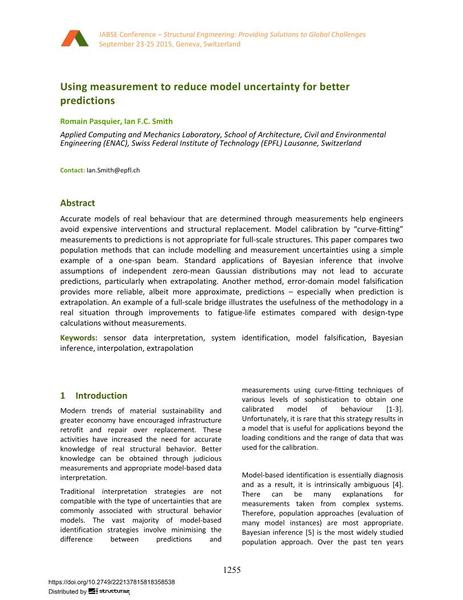Using measurement to reduce model uncertainty for better predictions

|
|
|||||||||||
Détails bibliographiques
| Auteur(s): |
Romain Pasquier
(Applied Computing and Mechanics Laboratory, School of Architecture, Civil and Environmental Engineering (ENAC), Swiss Federal Institute of Technology (EPFL) Lausanne, Switzerland)
Ian F. C. Smith (Applied Computing and Mechanics Laboratory, School of Architecture, Civil and Environmental Engineering (ENAC), Swiss Federal Institute of Technology (EPFL) Lausanne, Switzerland) |
||||
|---|---|---|---|---|---|
| Médium: | papier de conférence | ||||
| Langue(s): | anglais | ||||
| Conférence: | IABSE Conference: Structural Engineering: Providing Solutions to Global Challenges, Geneva, Switzerland, September 2015 | ||||
| Publié dans: | IABSE Conference Geneva 2015 | ||||
|
|||||
| Page(s): | 1255-1262 | ||||
| Nombre total de pages (du PDF): | 8 | ||||
| Année: | 2015 | ||||
| DOI: | 10.2749/222137815818358538 | ||||
| Abstrait: |
Accurate models of real behaviour that are determined through measurements help engineers avoid expensive interventions and structural replacement. Model calibration by “curve-fitting” measurements to predictions is not appropriate for full-scale structures. This paper compares two population methods that can include modelling and measurement uncertainties using a simple example of a one-span beam. Standard applications of Bayesian inference that involve assumptions of independent zero-mean Gaussian distributions may not lead to accurate predictions, particularly when extrapolating. Another method, error-domain model falsification provides more reliable, albeit more approximate, predictions – especially when prediction is extrapolation. An example of a full-scale bridge illustrates the usefulness of the methodology in a real situation through improvements to fatigue-life estimates compared with design-type calculations without measurements. |
||||
| Mots-clé: |
extrapolation
|
||||
